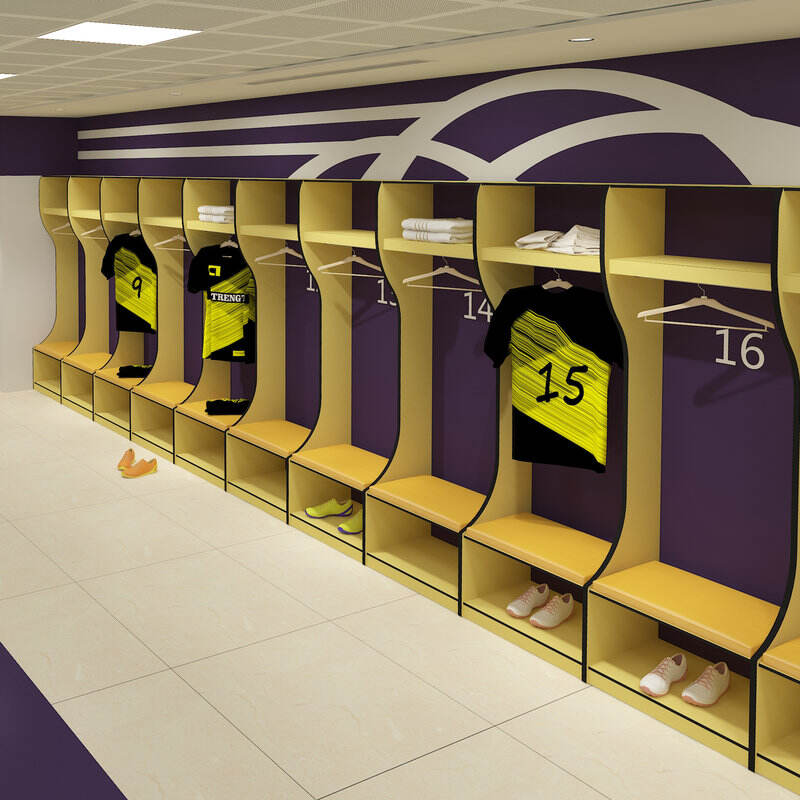Ar gyfer unrhyw un sy'n gwisgo'r chwarae pêl-droed, mae clociau yn darparu'r swyddogaeth sylfaenol o ddal offer amddiffyn, eiddo personol a chrysau, sy'n ei wneud yn ofynnol. Fodd bynnag, nid yw clociau pêl-droed yn union yr un fath â'r cloc neu'r fanerol, gan fod clociau pêl-droed hefyd angen cyfrif am ddyfeisiau llysnafus, llawn ffwlwr megis esgidiau clef, ffensiliau a chefnogion diogelwch, sy'n hynod agored i grwm ffwlwr ac felly, dal ffwlwr, ac yn agored i ffwrnais, niweidio a rhwymodau drwg. Mae ystafell groeso ar gyfer safle chwaraeon yn arbennig iawn, ac mae Jialifu yn darparu clociau ar gyfer safleoedd chwaraeon ers 23+ mlynedd i helpu â'r anghenion penodol hynny. Mae rheoli ffwlwr a hygrededd, yn ogystal â chronfeydd cyffredinol y ddyfeisiau mewn clociau pêl-droed yn gysylltiedig yn uniongyrchol â'r amodau aer a chyflwyno dan sylw isod.

Sgwrs y Cyflwyno: Aer digonol a phresenoldeb addas
Nid oes amheuaeth y gall atgyweiriadau pêl-droed angen llif aer digonol. Mae'r aer sydd ddim yn symud yn galluogi niwl i gasglu ac mae stagnu, wrth gwrs, yn ffactor allweddol i gynnydd ar niwl. Felly, rhaid bod gan atgyweiriadau nodweddion llif aer a gynlluniwyd er mwyn penodol, megis adranau ar agored ar gyfer cleidiau, ynghyd â phaneli ochr a phaneli ochr â bwlch aer a mwy, er mwyn galluogi aer newydd i fewnforio a haeloedd hen, tywyll i ddianc. Un enghraifft yw atgyweiriadau phenolic Jialifu a'r cefnogaeth i llif aer a chynlluniau'r atgyweiriadau ar agored sydd yn addasiadwy. Mewn cyfluniadau chwaraeon fel y VirgiMlio Gimnasio yn Sbaen, mae dillad llaith yn broblem. Ar gyfer ddyfais bêl-droed llaith, cynllunir atgyweiriadau felly bod yr adranau ynddynt wedi'u sealio, sy'n cadw'r offer yn llaith am oriau, felly, yn hwyluso tyfu môl. Mae môl yn nodwedd eithaf anodd i'r rhan fwyaf o atgyweiriadau. Mae model S o atgyweiriadau pêl-droed yn galluogi'r nodweddion hyn o fod â llif aer 'osod' a 'weithgar', sydd yn ddelfrydol ar gyfer rheoli môl.
Cynghori ar Ddŵr: Cefnogi Goleiddio gyda Dewis Defnydd
Mae rheoli cymaint y dŵr a'r oleiddio'n gweithio'n well gyda'r defnydd cywir. Mae locsiau bâl yn agored i ddŵr yn barhaus ac felly maen nhw angen bod yn rezistennol i ddŵr a chamgwyddau. Felly mae Jialifu yn defnyddio smwddf fenolig o ansawdd uchel a laminaad cryf, sy'n haws i'w glanhau ac nad ydynt yn cadw cymaint o ddŵr â goeden a metel arferol. Er enghraifft, mae locsiau phenolig yn ddiamod i warpage a chamgwyddau hyd yn hir wedi ymosodiadau ar gyfer offer llyfn, sy'n bositif ar gyfer oleiddio. Mae locsiau sydd wedi'u holeiddio â gwynt lân a sych yn llawer gwell na locsiau wnaed o ddefnydd porws a chyfradd ollaniad is. Mae dewis y defnydd cywir ar gyfer y lloc yn hanfodol ar gyfer oleiddio locsiau pêl-droed.
Adeiladwaith y Lloc: Esguswch Ardaloedd Lledfeydd Dŵr
Dylid osgoi cadw niwed yn rannau sydd mewn trafferth i'w gyrraedd wrth ddylunio clociau pêl-droed. Mae hyn yn golygu osgoi adranion dwfn, bach nad oes ganddynt drafod a'u hanelu trwy ddodrefnu elfennau dylunio fel silffoedd sydd ar draws neu arwynebau sydd wedi'u codi i ganiatáu i'r niwed ddodrannu oddi ar eitemau sydd wedi'u storio. Mae gan Jialifu'r gallu i addasu dyluniadau i ddod â chydraddoldeb i ddynod pêl-droed. Er enghraifft, mae gwahanu adranion ar gyfer esgidiau clwstnâg â gwaelodion agored a chrysiau â sili ffynhonnell er mwyn atal eitemau llyfn gwahanol o gorffwys ac ymddangosniad o niwed. Hyd yn hyn, hyd yn hyn fydd cloc sydd wedi'i adeiladu'n waethog yn sicr o gael ardaloedd marw ble mae niwed yn crymu a cheisio gweithredu.
Integreiddio â Systemau Goleuo'r Facylita
Ni weithredir loceri'n unigol – rhaid eu hadoli â'r system gweithredu ar gyfan y facyliad chwaraeon. Dylai system HVAC y tŷ loceri fod yn gallu cyflenwi aer newydd i ardal y loceri a dynnu aer llyfn trwy ffenestri trydoriad. Mae profiad prosiect Jialifu o weithio efo facyliadau chwaraeon ledled y byd wedi dangos bod hadoli cynlluniau loceri â llif aer y facyliad yn darparu gweithredu addas ar gyfer y loceri. Er enghraifft, mae gosod loceri ger agoredion aer, neu sicrhau bod y system trydoriad tŷ loceri yn weithgar yn ystod ac ar ôl ymarferion/pêl-droed yn helpu i dynnu cymylau o'r loceri yn gyflymach. Heb yr integreiddio hwn, bydd loceri – hyd yn oed rhai sydd â nodweddion cynllun gorau – yn anodd sychu, yn enwedig mewn ystafell â gweithredu drwg.
Hawdd i'w Gynnal: Cadw Nodweddion Gweithredu'n Weithgar
Mae angen cynnal a chadw ar nodweddion gwyryfu yn gardrobiaid pêl-droed yn rheolaidd i'w cadw'n effeithiol, fel nad yw'r gwyryfon, y trylau, a'r bylchau aer yn cael eu hamgáu'n llwyr â sylw, craflenni offer, neu sbwriel arall dros amser, sy'n arwain at orfodi llawn ar ffrwd yr aer. Dylai gardrobïau Jialifu, fel pob gardrobi, gael eu hadeiladu o dechnegau sydd yn hawdd eu glanhau, fel HPL a laminate crymynt. Ar gyfer gardrobïau eraill, mae dechrau cynllun cynnal a chadw yn cynnwys y system gardrobi sy'n ymwneud â gwirio a glanhau cydrannau gwyryfu: sgludo'r rhwydwaith gwyryfu, llysu'r ardaloedd sydd fwy tebygol o gael cymharedd, ac eriabu'r silff o unrhyw sbwriel a deunyddiau eraill. Bydd anwybyddu hir-dymor o'r cynnal a chadw hwn yn lleihau maint ffrwd yr aer a'r gwyryfu cyffredinol o fewn y gardrobïau.
Casgliad
Pan fo o ran gloiwr i gyneifion pêl-droed, mae angen sylw ar welltau, a dylai ganolbwyntio ar draffig aer, amddiffyniad rhag ysbryd, adeiladu, rhyngwynebau integredig â systemau eraill y facylita, gwasanaethu heb ormod, a ffactorau eraill. Mae'r ffactorau hyn yn cynhyrchu cyneifion sydd yn such, yn osgoi ffwrwm a chymer, ac yn hybu bywyd gwasanaeth y clociau. Mae gan Jialifu gloiwr ar gyfer ffrindiau a chyfleusterau chwaraeon o fewn phenolic a chamgrwm laminated, ynghyd â galluoedd addasu welltu datblygedig trwy dros 2000 o broiectau wedi'u cwblhau ledled y byd. Drwy fulfio'r gofynion hyn, gall facyltauthau chwaraeon ddarparu clociau yn iawn yn wellt, glân i chwaraewyr pêl-droed sy'n gallu helpu i wella eu perfformiad a'u lles.


